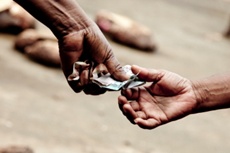Global poverty could be up to a third higher than reported
15 Apr 2014
With over one billion people in the world living on less than $1.25 per day, the World Bank aims to end 'extreme poverty' by 2030.
 But new research suggests that global poverty figures could be underestimated by up to a third, and calls for more robust measurement in the future.
But new research suggests that global poverty figures could be underestimated by up to a third, and calls for more robust measurement in the future.
The World Bank figures are widely used by the international community and play a significant role in international strategies to reduce poverty. Critics argue that its estimates are flawed because the 'dollar a day' poverty line is too arbitrary, and insufficiently anchored to any specification of basic human needs.
Researchers at the University of Bristol looked at those living on the Pacific island state of Vanuatu, taking into account not just their finances but also shelter, sanitisation, water, information, nutrition, health and education to build up a more comprehensive picture of poverty, deprivation and inequality.
The study, published in the Journal of Sociology, concludes that the World Bank is reporting a 'rosy' picture because the poverty line is set too low due to its narrow definition.
The research was carried out with colleagues at the Australian National University, University of New South Wales, UNICEF Pacific and the Vanuatu National Statistics Office, with funding from UNICEF Pacific and the Economic and Social Research Council (ESRC).
The findings come amidst considerable controversy surrounding the international 'dollar a day' measure used to monitor progress against the United Nation's Millennium Development Goals and the future direction of the post-2015 development agenda. The 'dollar a day' measure has been increased to $1.25, which is the equivalent of 75p.
The study found that five per cent of all children in Vanuatu live in poverty, as defined by the international 'dollar a day' measure. But a much greater proportion (17 per cent) live in poverty defined by the national food and basic needs poverty line; and absolute poverty, where people are deprived of two or more basic human needs, affects 16 per cent of children.
Dr Christopher Deeming, from Bristol University's School of Geographical Sciences, said, ''Our findings suggest that the current international poverty line of a dollar a day seriously underestimates global poverty levels. In the context of Vanuatu, our triangulated results suggest underestimation of poverty by at least a third in the population aged 17 years or under.
''If the World Bank had in fact used a poverty line grounded in basic needs, rather than its present artificial one which only looks at one monetary measure, the total number of poor people in the world would increase substantially, perhaps by as much as 30 per cent.
''It shows that measurement issues are extremely important and that different approaches can have a substantial impact on the level of poverty and deprivation measured and identified. We hope these findings will be taken into account in the future to ensure more robust analysis is carried out to give a clear picture of the social and economic challenges facing developing countries.''













.jpg)






.jpg)









